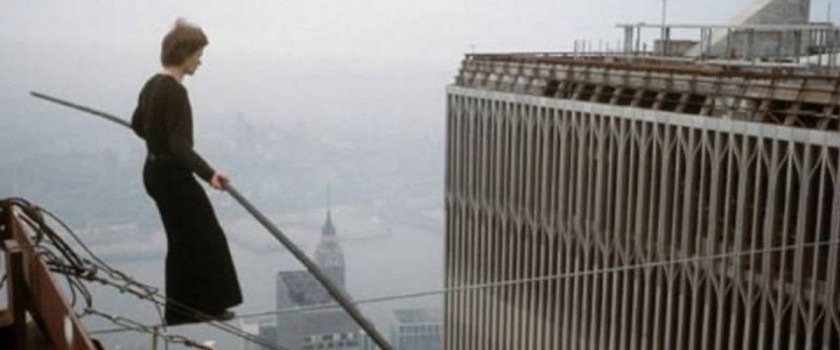| Worth seeing: | as a finely executed and thrilling blend of talking heads, reconstruction and archive footage to tell an unbelievable real-life story |

| Director: | James Marsh |
| Featuring: | Philippe Petit, Annie Allix, Barry Greenhouse, David Forman, Jean-François Heckel, Jean-Louis Blondeau, Jim Moore, Mark Lewis |
| Length: | 94 minutes |
| Certificate: | 12A |
| Country: | UK |
| Released: | 1st August 2008 |
WHAT’S IT ABOUT?
It was some fateful trip to the dentist for 1960s French teenager, Philippe Petit; in the newspaper he was reading in the waiting room, he saw something that would change his life.
As a young boy, Philippe liked to climb things – as he got older, that sense of adventure and danger developed into a love for tight-rope walking – and seeing in that paper that the Americans were building two towers, each nearly half a kilometre high, he decided that his calling in life was to walk a tight-rope between New York’s iconic World Trade Center twin towers.
What excited him most about his dream, at this stage, was that it didn’t even exist yet. How very French!
Come 1974 and the towers are nearing completion, but his dream is every bit as far away from reality. It never occurred to him to ask permission, so there began a secret mission to mount what he described as “the artistic crime of century.”
With dummy runs in Paris and Sydney, Philippe Petit and his gang of French friends and American and Australian accomplices plotted to smuggle a tonne of cable up one of the World Trade Center towers, stretch it across to the second tower and perform a wire-walk that had never been seen before and – profoundly – will never be seen again – all without being caught.
Using thirty four year old footage, re-enacting some of the unrecorded moments and interviewing all the key conspirators, director James Marsh reverts from narrative fiction to documentary to tell one of the most remarkable – and remarkably unbelievable – true stories to grace the big screen for years.
WHAT’S IT LIKE?
This is an odd cinema-going experience. Like all the best documentaries, it tells the real life story of something you just can’t believe can be real; as if carrying out a tight-rope walk between the twin towers isn’t a frightening enough prospect, the idea that it was carried out without permission blows your mind. How can we not even have known about this before this film?
If it had happened in the present day, it will have been filmed on mobile phones, but taking place in the 1970s, this was obviously not a luxury afforded to the conspirators, so much of the tension of the preparation is told through reconstructions, with a present-day narration from Petit himself, interspersed with interviews with his accomplices.
However, he had originally been planning to film his adventure, so to boost this production, he was able to provide 1970s footage of him putting together his team (like all the great caper movies) and practising walking a wire in his garden.
And here’s one of the most unbelievable things about this clever piece of film-making – even though the whole story is being told by the modern-day Philippe Petit, you find yourself gripping the edge of your seat, as you watch the contemporary still photos of the final balancing act, wondering “Can he possibly survive this breath-taking endeavour?”
In many ways – the reconstructions and the disbelief that the protagonists could have survived despite the fact we are watching them – this emulates the success of 2003’s Touching the Void.
But unlike the earlier film, this is imbued with the added poignancy of knowing that the feat simply cannot be repeated – when he first came up with his dream, it did not exist and now, it can never exist again.
And like all the best narrative fiction movies, this is bursting with ironic humour (the police news conference at the end is worth the ticket price alone) and drama, positive and negative emotions, and the story even manages to work in infidelity and broken friendships as one insane Frenchman pursues his insane dream.
Petit’s enthusiasm is contagious – if you see an increase in the number of adults walking atop walls and railings in the streets, you’ll know why.
